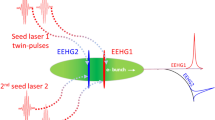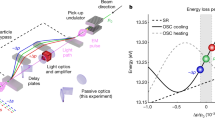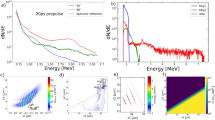Abstract
The use of particle accelerators as photon sources has enabled advances in science and technology1. Currently the workhorses of such sources are storage-ring-based synchrotron radiation facilities2,3,4 and linear-accelerator-based free-electron lasers5,6,7,8,9,10,11,12,13,14. Synchrotron radiation facilities deliver photons with high repetition rates but relatively low power, owing to their temporally incoherent nature. Free-electron lasers produce radiation with high peak brightness, but their repetition rate is limited by the driving sources. The steady-state microbunching15,16,17,18,19,20,21,22 (SSMB) mechanism has been proposed to generate high-repetition, high-power radiation at wavelengths ranging from the terahertz scale to the extreme ultraviolet. This is accomplished by using microbunching-enabled multiparticle coherent enhancement of the radiation in an electron storage ring on a steady-state turn-by-turn basis. A crucial step in unveiling the potential of SSMB as a future photon source is the demonstration of its mechanism in a real machine. Here we report an experimental demonstration of the SSMB mechanism. We show that electron bunches stored in a quasi-isochronous ring can yield sub-micrometre microbunching and coherent radiation, one complete revolution after energy modulation induced by a 1,064-nanometre-wavelength laser. Our results verify that the optical phases of electrons can be correlated turn by turn at a precision of sub-laser wavelengths. On the basis of this phase correlation, we expect that SSMB will be realized by applying a phase-locked laser that interacts with the electrons turn by turn. This demonstration represents a milestone towards the implementation of an SSMB-based high-repetition, high-power photon source.
This is a preview of subscription content, access via your institution
Access options
Access Nature and 54 other Nature Portfolio journals
Get Nature+, our best-value online-access subscription
$29.99 / 30 days
cancel any time
Subscribe to this journal
Receive 51 print issues and online access
$199.00 per year
only $3.90 per issue
Buy this article
- Purchase on Springer Link
- Instant access to full article PDF
Prices may be subject to local taxes which are calculated during checkout



Similar content being viewed by others
Data availability
The raw data from this experiment are available at https://doi.org/10.5061/dryad.r7sqv9s9f.
Code availability
The computer codes used for the data analysis are available at https://doi.org/10.5061/dryad.r7sqv9s9f.
References
Chao, A. W. & Chou, W. Reviews of Accelerator Science and Technology – Volume 3: Accelerators as Photon Sources (World Scientific, 2011).
Elder, F. R., Gurewitsch, A. M., Langmuir, R. V. & Pollock, H. C. Radiation from electrons in a synchrotron. Phys. Rev. 71, 829–830 (1947).
Schwinger, J. On the classical radiation of accelerated electrons. Phys. Rev. 75, 1912–1925 (1949).
Zhao, Z. T. Storage ring light sources. Rev. Accel. Sci. Technol. 3, 57–76 (2010).
Madey, J. M. Stimulated emission of bremsstrahlung in a periodic magnetic field. J. Appl. Phys. 42, 1906–1913 (1971).
Deacon, D. A. G. et al. First operation of a free-electron laser. Phys. Rev. Lett. 38, 892–894 (1977).
Billardon, M. et al. First operation of a storage-ring free-electron laser. Phys. Rev. Lett. 51, 1652–1655 (1983).
Kondratenko, A. & Saldin, E. Generating of coherent radiation by a relativistic electron beam in an ondulator. Part. Accel. 10, 207–216 (1980).
Bonifacio, R., Pellegrini, C. & Narducci, L. Collective instabilities and high-gain regime in a free-electron laser. Opt. Commun. 50, 373–378 (1984).
Hogan, M. et al. Measurements of gain larger than 105 at 12 μm in a self-amplified spontaneous-emission free-electron laser. Phys. Rev. Lett. 81, 4867–4870 (1998).
Andruszkow, J. et al. First observation of self-amplified spontaneous emission in a free-electron laser at 109 nm wavelength. Phys. Rev. Lett. 85, 3825–3829 (2000).
Milton, S. et al. Exponential gain and saturation of a self-amplified spontaneous emission free-electron laser. Science 292, 2037–2041 (2001).
Emma, P. et al. First lasing and operation of an ångstrom-wavelength free-electron laser. Nat. Photon. 4, 641–647 (2010).
Seddon, E. A. et al. Short-wavelength free-electron laser sources and science: a review. Rep. Prog. Phys. 80, 115901 (2017).
Ratner, D. F. & Chao, A. W. Steady-state microbunching in a storage ring for generating coherent radiation. Phys. Rev. Lett. 105, 154801 (2010).
Ratner, D. & Chao, A. Reversible seeding in storage rings. In Proc. of the 33th International Free-electron Laser Conference (JACoW, 2011); https://accelconf.web.cern.ch/AccelConf/FEL2011/papers/mopb23.pdf
Jiao, Y., Ratner, D. F. & Chao, A. W. Terahertz coherent radiation from steady-state microbunching in storage rings with X-band radio-frequency system. Phys. Rev. Spec. Top. Accel. Beams 14, 110702 (2011).
Chao, A. et al. High power radiation sources using the steady-state microbunching mechanism. In Proc. of the 7th International Particle Accelerator Conference (JACoW, 2016); http://accelconf.web.cern.ch/AccelConf/IPAC2016/papers/tuxb01.pdf
Tang, C. et al. An overview of the progress on SSMB. In Proc. of the 60th ICFA Advanced Beam Dynamics Workshop on Future Light Sources (JACoW, 2018); http://accelconf.web.cern.ch/AccelConf/fls2018/papers/thp2wb02.pdf
Chao, A. et al. A Compact High-Power Radiation Source Based on Steady-State Microbunching Mechanism. Technical Report No. SLAC-PUB-17241 (Stanford Linear Accelerator Center, 2018).
Deng, X. et al. From coherent harmonic generation to steady state microbunching. In Proc. of the 9th International Particle Accelerator Conference (JACoW, 2018); https://accelconf.web.cern.ch/AccelConf/ipac2018/papers/thpmk113.pdf
Deng, X. J. et al. Single-particle dynamics of microbunching. Phys. Rev. Accel. Beams 23, 044002 (2020).
Nodvick, J. S. & Saxon, D. S. Suppression of coherent radiation by electrons in a synchrotron. Phys. Rev. 96, 180–184 (1954).
Williams, G. P. et al. Coherence effects in long-wavelength infrared synchrotron radiation emission. Phys. Rev. Lett. 62, 261–263 (1989).
Gover, A. et al. Superradiant and stimulated-superradiant emission of bunched electron beams. Rev. Mod. Phys. 91, 035003 (2019).
Bakshi, V. EUV Lithography 2nd edn (SPIE Press, 2018).
Damascelli, A., Hussain, Z. & Shen, Z. X. Angle-resolved photoemission studies of the cuprate superconductors. Rev. Mod. Phys. 75, 473–541 (2003).
Lv, B., Qian, T. & Ding, H. Angle-resolved photoemission spectroscopy and its application to topological materials. Nat. Rev. Phys. 1, 609–626 (2019).
Carr, G. et al. High-power terahertz radiation from relativistic electrons. Nature 420, 153–156 (2002).
Cole, B. E., Williams, J. B., King, B. T., Sherwin, M. S. & Stanley, C. R. Coherent manipulation of semiconductor quantum bits with terahertz radiation. Nature 410, 60–63 (2001).
Krausz, F. & Misha, I. Attosecond physics. Rev. Mod. Phys. 81, 163–234 (2009).
Veksler, V. I. New method for the acceleration of relativistic particles. Dokl. Akad. Nauk SSSR 43, 346–348 (1944).
McMillan, E. M. The synchrotron—a proposed high energy particle accelerator. Phys. Rev. 68, 143–144 (1945).
Girard, B. et al. Optical frequency multiplication by an optical klystron. Phys. Rev. Lett. 53, 2405–2408 (1984).
Yu, L. H. Generation of intense UV radiation by subharmonically seeded single-pass free-electron lasers. Phys. Rev. A 44, 5178–5193 (1991).
Yu, L.-H. et al. High-gain harmonic-generation free-electron laser. Science 289, 932–934 (2000).
Hemsing, E., Stupakov, G., Xiang, D. & Zholents, A. Beam by design: laser manipulation of electrons in modern accelerators. Rev. Mod. Phys. 86, 897–941 (2014).
Byrd, J. M. et al. Observation of broadband self-amplified spontaneous coherent terahertz synchrotron radiation in a storage ring. Phys. Rev. Lett. 89, 224801 (2002).
Venturini, M. & Robert, W. Bursts of coherent synchrotron radiation in electron storage rings: a dynamical model. Phys. Rev. Lett. 89, 224802 (2002).
Walker, R. P. et al. First lasing and initial performance of the European UV/VUV storage ring FEL at ELETTRA. Nucl. Instrum. Methods Phys. Res. A 475, 20–27 (2001).
Trovò, M. et al. Operation of the European storage ring FEL at ELETTRA down to 190 nm. Nucl. Instrum. Methods Phys. Res. A 483, 157–161 (2002).
Feikes, J. et al. Metrology Light Source: the first electron storage ring optimized for generating coherent THz radiation. Phys. Rev. Spec. Top. Accel. Beams 14, 030705 (2011).
Ries, M. Nonlinear Momentum Compaction and Coherent Synchrotron Radiation at the Metrology Light Source. PhD thesis, Humboldt Univ. of Berlin (2014).
Sands, M. The Physics of Electron Storage Rings: an Introduction. Technical Report No. SLAC-121 (Stanford Linear Accelerator Center, 1970).
Shoji, Y., Tanaka, H., Takao, M. & Soutome, K. Longitudinal radiation excitation in an electron storage ring. Phys. Rev. E 54, R4556–R4559 (1996).
Pellegrini, C. & Robin, D. Quasi-isochronous storage ring. Nucl. Instrum. Methods Phys. Res. A 301, 27–36 (1991).
Tanaka, T. & Hideo, K. SPECTRA: a synchrotron radiation calculation code. J. Synchrotron Radiat. 8, 1221–1228 (2001).
Piwinski, A. Intra-beam Scattering. Technical Report No. DESY-H1–73–3 (Deutsches Elektronen-Synchrotron, 1974).
Bjorken, J. D. & Mtingwa, S. K. in Particle Accelerators Vol. 13, 115–143 (Gordon and Breach, 1983).
Chao, A. W. Physics of Collective Beam Instabilities in High Energy Accelerators (Wiley, 1993).
Bernardini, C. et al. Lifetime and beam size in a storage ring. Phys. Rev. Lett. 10, 407–409 (1963).
Shoji, Y. Bunch lengthening by a betatron motion in quasi-isochronous storage rings. Phys. Rev. Spec. Top. Accel. Beams 7, 090703 (2004).
Shimada, M. et al. Transverse-longitudinal coupling effect in laser bunch slicing. Phys. Rev. Lett. 103, 144802 (2009).
Courant, E. D. & Snyder, H. S. Theory of the alternating-gradient synchrotron. Ann. Phys. 3, 1–48 (1958).
Shoji, Y. Dependence of average path length betatron motion in a storage ring. Phys. Rev. Spec. Top. Accel. Beams 8, 094001 (2005).
Machida, S. et al. Amplitude-dependent orbital period in alternating gradient accelerators. Prog. Theor. Exp. Phys. 2016, 033G01 (2016).
Deng, X. J. et al. Widening and distortion of the particle energy distribution by chromaticity in quasi-isochronous rings. Phys. Rev. Accel. Beams 23, 044001 (2020).
Falkenstern, F., Hoffmann, F., Kuske, P. & Kuszynski, J. Bunch view – a fast and accurate bunch-by-bunch current monitor. In Proc. of DIPAC09 128–130 (Paul Scherrer Institute, 2009).
Klein, R. et al. Operation of the Metrology Light Source as a primary radiation source standard. Phys. Rev. Spec. Top. Accel. Beams 11, 110701 (2008).
Acknowledgements
This work is partially supported by the Tsinghua University Initiative Scientific Research Program number 20191081195, China. We appreciate the continuous support of A. Jankowiak (HZB) and M. Richter (PTB), which made the experiment possible.
Author information
Authors and Affiliations
Contributions
A.C. is one of the authors who conceived the original theoretical concept of SSMB and has been promoting SSMB research and collaboration. Together with A.C., the Tsinghua SSMB group, led by C.T., initiated the experiment. J.F., J.L. and M.R. prepared the setup of the storage ring for the experiment and together with Y.P. and A.M. performed the experiment at the MLS. L.Y., W.H., C.T. and X.D. designed and developed the laser scheme and related optical system. R.K., A.H. and L.Y. set up the laser system and the laser beam control, as well as the coherent detection part, and together with A.K. performed the experiment. X.D. defined the experimental parameter set, conducted the simulations and analysed the beam dynamics and experimental data. X.D. wrote the paper, with revisions from A.C., J.F., M.R. and C.T. All authors participated in the experiment.
Corresponding authors
Ethics declarations
Competing interests
The authors declare no competing interests.
Additional information
Peer review information Nature thanks Jie Gao and the other, anonymous, reviewer(s) for their contribution to the peer review of this work. Peer reviewer reports are available.
Publisher’s note Springer Nature remains neutral with regard to jurisdictional claims in published maps and institutional affiliations.
Extended data figures and tables
Extended Data Fig. 1 The MLS quasi-isochronous magnet lattice used to generate microbunching.
The magnet lattice and the key are shown at the top. The curves are the model horizontal (red) and vertical (blue) β functions and the horizontal dispersion Dx (green). Operating parameters of the ring: beam energy, E0 = 250 MeV; relative energy spread, σδ = 1.8 × 10−4 (model); horizontal emittance, ϵx = 31 nm (model); horizontal betatron tune, νx = 3.18 (model and measured); vertical betatron tune, νy = 2.23 (model and measured); horizontal chromaticity, ξx = −0.5 (measured).
Extended Data Fig. 2 Fluctuating temporal profiles of the multi-longitudinal-mode laser.
a, Temporal profiles of two example consecutive laser shots (red and blue) and the averaged waveform of 200 consecutive laser shots (black). b, Statistical distribution of the laser power at t = 0 ns in a for 10,000 consecutive laser shots, where the red curve is a gamma distribution fit. Laser: compact Nd:YAG Q-switched laser (Beamtech Optronics Dawa-200). Detector: ultrafast photodetectors (Alphas UPS-40-UVIR-D; rise time < 40 ps). Measurement system: digital oscilloscope (Teledyne LeCroy WM825Zi-B; bandwidth 25 GHz; sample rate 80 billion samples per second).
Extended Data Fig. 3 Measurement and evaluation of bunch charge.
Blue dots are the measurement results with the systematic offset subtracted and the red curve is a fit by the sum of two exponential functions, Q(t) = Q1exp(−t/τ1) + Q2exp(−t/τ2), performed at different time intervals, with the fit results connected by a smoothed line.
Extended Data Fig. 4 Linear dependence of the broadband incoherent undulator radiation on the bunch charge.
a, Results corresponding to individual laser shots; the shading (light red) represents 3σ of the detection noise. b, The result after 200-consecutive-laser-shot averaging. The blue dots are the experimental data of a bunch not modulated by the laser and the red curves are linear fits.
Extended Data Fig. 5 Quadratic dependence of the narrowband coherent undulator radiation generated from microbunching on the bunch charge.
a, Results corresponding to individual laser shots; the shading (light red and grey) represents 3σ of the detection noise. b, The result after 200-consecutive-laser-shot averaging; the plot is the same as Fig. 3 and is presented again here for comparison with a and with the incoherent signal in Extended Data Fig. 4. The blue dots represent the experimental data and the red curves are quadratic fits.
Supplementary information
Rights and permissions
About this article
Cite this article
Deng, X., Chao, A., Feikes, J. et al. Experimental demonstration of the mechanism of steady-state microbunching. Nature 590, 576–579 (2021). https://doi.org/10.1038/s41586-021-03203-0
Received:
Accepted:
Published:
Issue Date:
DOI: https://doi.org/10.1038/s41586-021-03203-0
This article is cited by
-
Generating high repetition rate X-ray attosecond pulses in a diffraction limited storage ring
Scientific Reports (2023)
-
Effective DC acceleration of charged particles in a circular ring and its potential application
Scientific Reports (2023)
-
A synchrotron-based kilowatt-level radiation source for EUV lithography
Scientific Reports (2022)
-
Energy recovery linac based fully coherent light source
Scientific Reports (2021)
-
A compact electron storage ring for lithographical applications
Nuclear Science and Techniques (2021)
Comments
By submitting a comment you agree to abide by our Terms and Community Guidelines. If you find something abusive or that does not comply with our terms or guidelines please flag it as inappropriate.



